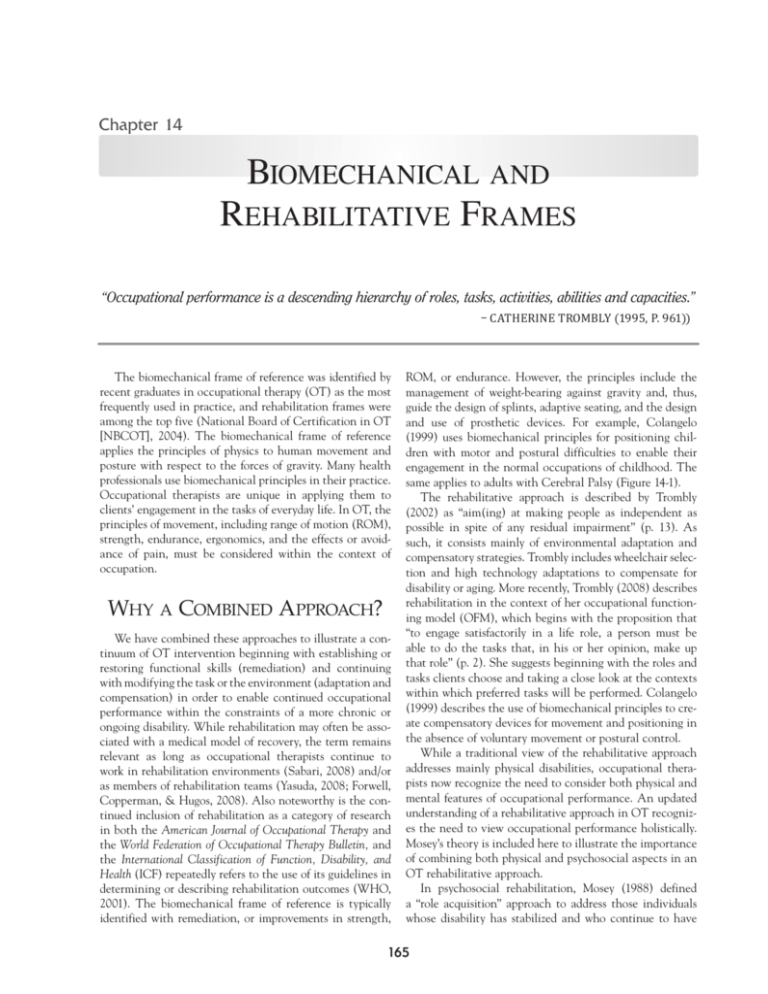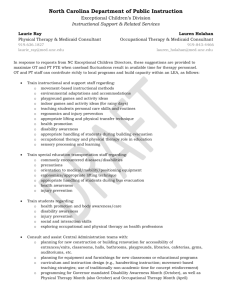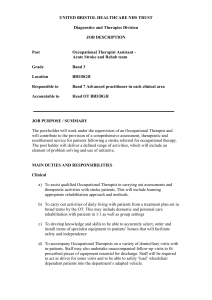BIOMECHANICAL AND REHABILITATIVE FRAMES
advertisement

Chapter 14 Biomechanical and Rehabilitative Frames “Occupational performance is a descending hierarchy of roles, tasks, activities, abilities and capacities.” – Catherine Trombly (1995, p. 961)) The biomechanical frame of reference was identified by recent graduates in occupational therapy (OT) as the most frequently used in practice, and rehabilitation frames were among the top five (National Board of Certification in OT [NBCOT], 2004). The biomechanical frame of reference applies the principles of physics to human movement and posture with respect to the forces of gravity. Many health professionals use biomechanical principles in their practice. Occupational therapists are unique in applying them to clients’ engagement in the tasks of everyday life. In OT, the principles of movement, including range of motion (ROM), strength, endurance, ergonomics, and the effects or avoidance of pain, must be considered within the context of occupation. Why a Combined Approach? We have combined these approaches to illustrate a continuum of OT intervention beginning with establishing or restoring functional skills (remediation) and continuing with modifying the task or the environment (adaptation and compensation) in order to enable continued occupational performance within the constraints of a more chronic or ongoing disability. While rehabilitation may often be associated with a medical model of recovery, the term remains relevant as long as occupational therapists continue to work in rehabilitation environments (Sabari, 2008) and/or as members of rehabilitation teams (Yasuda, 2008; Forwell, Copperman, & Hugos, 2008). Also noteworthy is the continued inclusion of rehabilitation as a category of research in both the American Journal of Occupational Therapy and the World Federation of Occupational Therapy Bulletin, and the International Classification of Function, Disability, and Health (ICF) repeatedly refers to the use of its guidelines in determining or describing rehabilitation outcomes (WHO, 2001). The biomechanical frame of reference is typically identified with remediation, or improvements in strength, ROM, or endurance. However, the principles include the management of weight-bearing against gravity and, thus, guide the design of splints, adaptive seating, and the design and use of prosthetic devices. For example, Colangelo (1999) uses biomechanical principles for positioning children with motor and postural difficulties to enable their engagement in the normal occupations of childhood. The same applies to adults with Cerebral Palsy (Figure 14-1). The rehabilitative approach is described by Trombly (2002) as “aim(ing) at making people as independent as possible in spite of any residual impairment” (p. 13). As such, it consists mainly of environmental adaptation and compensatory strategies. Trombly includes wheelchair selection and high technology adaptations to compensate for disability or aging. More recently, Trombly (2008) describes rehabilitation in the context of her occupational functioning model (OFM), which begins with the proposition that “to engage satisfactorily in a life role, a person must be able to do the tasks that, in his or her opinion, make up that role” (p. 2). She suggests beginning with the roles and tasks clients choose and taking a close look at the contexts within which preferred tasks will be performed. Colangelo (1999) describes the use of biomechanical principles to create compensatory devices for movement and positioning in the absence of voluntary movement or postural control. While a traditional view of the rehabilitative approach addresses mainly physical disabilities, occupational therapists now recognize the need to consider both physical and mental features of occupational performance. An updated understanding of a rehabilitative approach in OT recognizes the need to view occupational performance holistically. Mosey’s theory is included here to illustrate the importance of combining both physical and psychosocial aspects in an OT rehabilitative approach. In psychosocial rehabilitation, Mosey (1988) defined a “role acquisition” approach to address those individuals whose disability has stabilized and who continue to have 165



